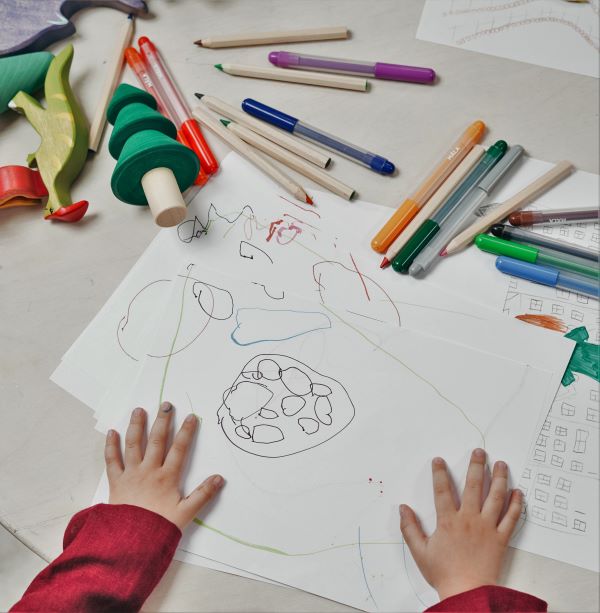VISUAL PROMPT
Inspired by SLW

Describe a young child's drawing as if it were a professional piece of art in a gallery. You could make it funny, or try to apply real principals of painting.
A Masterpiece for the Ages
Let us consider the composition as a whole. At first glance, one might dismiss it as a mere scattering of blots and wayward lines. But upon deeper inspection, one becomes aware of three dominant 'focal splotches'—a term I have recently coined to describe this artist’s manifestations of painterly prowess. These focal splotches vary dramatically in color, texture, and medium, lending the piece a dynamic visual tension.
The upper left quadrant is particularly striking, boasting an apple-sized splotch in a fiery reddish-orange hue. Scientific analysis reveals the medium to be none other than "Chef" paint—a mixture sourced from a can of the beloved children's pasta, Chef Boyardee. Here, the artist deftly employs this unconventional medium to evoke a profound sense of childhood exuberance and unbridled innocence. Look closely, and you will notice that this splotch is, in fact, a delicate layering of two distinct blobs, each offset from the other to create a masterful play of dimension. Encircling this central motif, a jagged, dark circle made with a fine marker undulates in varying thicknesses, its irregular, incomplete form teasing the mind's eye, engaging both hemispheres of the brain as it beckons the viewer to fill in the missing fragments.
Moving to the upper right quadrant, we encounter a simple blue squiggle made with crayon encased within an open oval. The deliberate lack of topological accuracy serves as a poignant counterpoint to the elaborate Chef-based blot. The intentional misalignment of these elements injects a playful spirit into the composition, a whimsical wink to the viewer.
Below, across the bottom hemisphere, we find the pièce de résistance: a nebulous, cloud-like circle that functions as the mouthpiece of this enigmatic face. The choice of a humble No. 2 pencil here is nothing short of genius, steering the eye upward toward the more vibrant orbs while simultaneously creating a shadow effect through the liberal use of hand and feet smudges. One cannot help but admire the artist's restraint and finesse, blending bold strokes with a otherworldly vibe.
Around the perimeter and strategically interspersed throughout, we find what I refer to as “tiny moments”—micro touches that elevate this work to a realm beyond the ordinary. The carefully placed Chef paint in the top left of the canvas, the greenish grass and broccoli stains that bisect the horizontal center, and the minuscule pencil, chocolate, and gummy bear globs that serve to mimic facial markings, birthmarks, or even the imperfections of a soul. These details are not mere embellishments; they are the artist's way of inviting us to linger, to revel in the imperfections that make life so achingly beautiful.
In sum, the artist has crafted a visual odyssey—a journey that reflects back upon us, a face that seems both familiar and foreign, inviting us to reclaim our own sense of wonder. This work is a celebration of life's messy, joyous moments, a tangible testament to the sublime dance between chaotic complexity and minimalist mirth. One might even say it heralds the dawn of a new era—an era in which the next generation of Picassos find their voice amidst the joyful cacophony of childhood.
Truly, a masterpiece for the ages.
